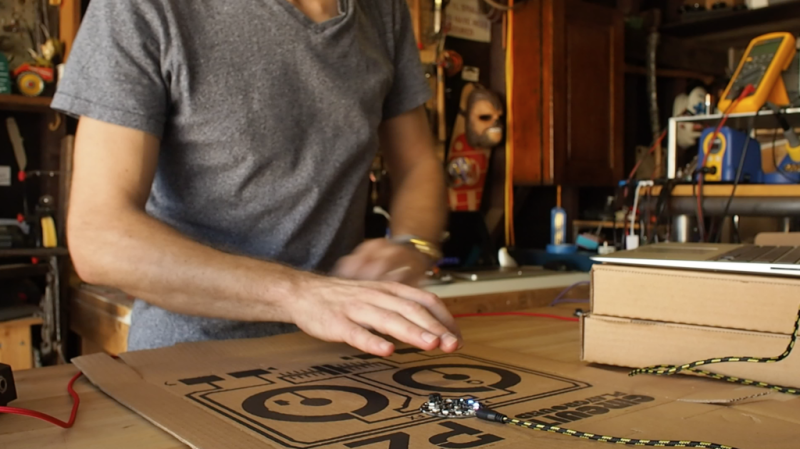Conductive paints and inks have been around for quite sometime, and the internet abounds with examples of cool projects you can use them for. They’re well suited to quick and fun prototypes, educational workshops, and temporary toys. But, as cool as conductive paint is, it’s not usually the kind of thing that gets people excited at parties.
Well, until now that is. Adafruit has published a dope guide for building a bomb-diggity DJ mixing station out of a pizza box, conductive paint, and a Circuit Playground board. The guide walks you through how to properly apply the conductive paint (in this case using a stencil to lay it onto a cardboard pizza box), wire it up using the Circuit Playground, and integrate it into popular DJ software.
Sure, your sister’s “professional” DJ boyfriend may scoff at it, but it’ll still let you lay down some boss beats. And, when the bass drops nobody will care that you’re scratching a Domino’s box. Of course, there are other options out there if you want a more permanent solution.
















Pizza Hut did this, but only in the UK. https://www.youtube.com/watch?v=MjupT9LJe9E
Is it just 8 buttons or are those rotary encoders that pass for those mammary controls real and they sense rotation. If so that pizza box and ‘duino is a lot cheaper than 2 turntables and those timecode “records” and their interface.
I think it would be cool to wave the segue from left fo right with a kinect.
They’re using the capacitance button sensor in the board, and using all of the stenciled paths as digital buttons… except for the one connected to the right circle, which feeds its raw capacitance value to one of the MIDI CCs
Is there any conductive paint or tape that is transparent or close to transparent?
There is a solution that can be used on glass to provide connections to LCD segments, but I forget what it is.
Hard way: ITO.
Easy way: Touch screen overlay.
Touch screen overlay will probably not work (cost wise) for my use case. I want add touch controls to a large (A1 size) poster, or more precisely to the plastic cover of the poster’s frame. Can you say more on ITO? Specific product names? Is it at all feasible for not very advanced DIY use?
ITO = indium tin oxide is a ceramic, so you’re going to have a hard time applying it to things that aren’t very rigid, lest it break and cease to conduct.
If you are applying it to a substrate that can handle high temperature, you can make a useful chlorine doped tin oxide coating. If applied thin enough it is transparent and has high conductivity.
https://www.youtube.com/watch?v=eTLGtgYtL08
Otherwise vapor deposition or sputtering would be required (like they do for plastic substrates).
Otherwise vapor deposition or sputtering would be required (like they do for plastic substrates).
Thanks Dave and rnj, that’s the kind of thing I was trying to fish out of the mental sink hole.
Now I come to think of it, I think you can find some ideas about such processes in the solar energy, evil genius book.
ITO coated sheets would require you to chemically or laser etch your pattern.
There are many DIY touchscreens to be found. Mostly IR LED and receiver strips, or simpler IR laser and receiver strips.
A novel approach is using an old scanner line ccd and a couple of LEDs: http://pcbheaven.com/opendir/index.php?show=340zw1018arc0f77c83
Kudos for recycling obsolete electronics.
Oh, considering what you’re trying to do though, I think capacitative touch methods will work through the poster, meaning you can either conductive paint right on the back of it, or you can use a giant PCB, or even just lay wire in grooves routed, sliced or pressed into soft wood.
As RW says, hide the capacitive layer behind the poster. Lots of toy computers from the early 90s had keyboards made that way. The TI Talking Master Mouse Computer for example.
[IMG]http://i63.tinypic.com/2h7qumq.jpg[/IMG]
You can buy ready-made ITO coated clear plastic sheets.
A1 size looks a bit hard to find. Only source I see so far is a roll you could cut it from for $299!
“Adafruit has published a dope guide”
Dope? Really? Come on, guys..
Wow. You didn’t notice all the rest of the ironic coolness that article was drenched with?
The cat is just square, wigging not digging. I’m hep tho’, it’s cooking.
Dude, irony stopped being cool 15 years ago. No idea what they replaced it with, though. I don’t think it was sincerity.